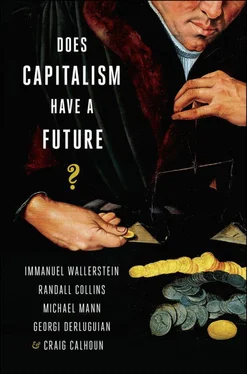Immanuel Wallerstein - Does Capitalism Have a Future?
Здесь есть возможность читать онлайн «Immanuel Wallerstein - Does Capitalism Have a Future?» весь текст электронной книги совершенно бесплатно (целиком полную версию без сокращений). В некоторых случаях можно слушать аудио, скачать через торрент в формате fb2 и присутствует краткое содержание. Город: New York, Год выпуска: 2013, ISBN: 2013, Издательство: Oxford University Press, Жанр: Публицистика, sci_economy, на английском языке. Описание произведения, (предисловие) а так же отзывы посетителей доступны на портале библиотеки ЛибКат.
- Название:Does Capitalism Have a Future?
- Автор:
- Издательство:Oxford University Press
- Жанр:
- Год:2013
- Город:New York
- ISBN:978-0-19-933084-3
- Рейтинг книги:5 / 5. Голосов: 1
-
Избранное:Добавить в избранное
- Отзывы:
-
Ваша оценка:
- 100
- 1
- 2
- 3
- 4
- 5
Does Capitalism Have a Future?: краткое содержание, описание и аннотация
Предлагаем к чтению аннотацию, описание, краткое содержание или предисловие (зависит от того, что написал сам автор книги «Does Capitalism Have a Future?»). Если вы не нашли необходимую информацию о книге — напишите в комментариях, мы постараемся отыскать её.
Does Capitalism Have a Future? — читать онлайн бесплатно полную книгу (весь текст) целиком
Ниже представлен текст книги, разбитый по страницам. Система сохранения места последней прочитанной страницы, позволяет с удобством читать онлайн бесплатно книгу «Does Capitalism Have a Future?», без необходимости каждый раз заново искать на чём Вы остановились. Поставьте закладку, и сможете в любой момент перейти на страницу, на которой закончили чтение.
Интервал:
Закладка:
This pattern of expansion and contraction of capitalism is only possible because capitalism is not a system that is located within a single state, but is rather ensconced in a world-system, larger by definition than any single state. If these processes were occurring in a single state, there would be nothing to prevent the holders of state power from appropriating the surplus value, which would remove (or at least considerably reduce) the incentive of entrepreneurs to develop new products. On the other hand, were there no states whatsoever within the range of the market, there would be no way to obtain quasi-monopolies. It is only if capitalists are located in a “world-economy”—one that has a multiplicity of states within it—that entrepreneurs can pursue the endless accumulation of capital.
This then explains why we have so-called hegemonic cycles, ones that are considerably longer than the Kondratieff cycles. What is meant by hegemony in a world-economy is the ability of one state to impose a set of rules on the operation of all other states, such that there is relative order in the world-system. The importance of “relative” order is something on which Schumpeter insisted in his theorizing. Disorders—interstate and intrastate (civil) wars, mafiosi protection rackets, extensive official and institutional corruption, rampant petty crime—are all profitable to small sectors of the world’s population. But they all hinder the global search for maximizing the accumulation of capital. Indeed, they bring about the destruction of much infrastructure necessary for the maintenance and expansion of capitalist accumulation.
It follows that the imposition of relative order by a hegemonic power is a positive benefit for the “normal” operation of the capitalist system as a whole. It is also of great benefit to the hegemonic power itself—its state, its entrepreneurs, its ordinary citizens. There is reason to doubt that the benefits to the system as a whole (and to the hegemonic power) also bring in their wake a benefit to other states and their enterprises and citizens. Therein lays the tension, and the explanation, of why achieving and maintaining hegemony is so difficult and so rare.
The pattern of hegemonic cycles heretofore has been that after a very destructive “thirty years’ war” between the two powers that had been in the best position to seek to be the dominant power in the world-system, one of them wins out decisively. At that point, one state combines in its economic processes marked advantage simultaneously in all three forms of economic activity—production, commerce, and finance. Such a state furthermore enjoys, as a result of its strong economic base and its successful victory in the previous struggle, a significant military edge. And to cap its overall position, it asserts cultural dominance, including the defining version of the geoculture (Gramsci’s concept of hegemony).
With this combination of preeminence in all spheres of the world-system, it can obtain its objectives and impose its will, most of the way most of the time. We may think of this as a quasi-monopoly of geopolitical power. At the outset, this hegemonic dominance does indeed create relative order in the world-system and relative stability. The problem here, as in the case of the quasi-monopolies of leading industries, is that quasi-monopolies of geopolitical power are self-liquidating, for several reasons.
First, there are always clear losers in a situation of relative stability. They begin to rebel in multiple ways. To contain their rebellions, the hegemonic power finds it necessary to engage in repressive activities, often military activities. Repressive activities may often be, in the immediate sense, quite successful. But the use of force always brings with it two negative consequences. The military action is often less than totally successful, thereby exposing some limitations to the hegemonic power’s repressive powers. This thereupon tends to embolden future shows of defiance.
Secondly, the employment of repressive force contains a price for the armies and other institutions of the hegemonic power. The cost in lives (deaths and damaged lives) grows steadily. And the financial costs begin to mount. Slowly but surely, this undermines the popular support for this activity, as the populace begins to perceive more clearly the gains (usually disproportionately to a subset of the hegemonic power’s population) and the losses (usually to a much larger subset). As a result, the authorities of a hegemonic power begin to feel internal constraints on their ability to impose world order.
Thirdly, other states, which had fallen far behind the hegemonic power in terms of geopolitical strength at the beginning of the period of hegemonic dominance, begin to recover their strength and begin to insist on a larger geopolitical role. The world-system begins to move away from a situation of undisputed hegemony to a situation of balance of powers. Since the process is cyclical, there begin to be efforts by others to seek the role of successor hegemonic power. But this is a complicated and arduous process, which explains why hegemonic cycles are so much longer than Kondratieff cycles. [2] I explain this process in “The Concept of Hegemony in a World-Economy,” in Prologue to the 2011 Edition of The Modern World-System, II: Mercantilism and the Consolidation of the European World-Economy, 1600–1750 (Berkeley: Univ. of California Press, 2011), xxii–xxvii.
Because of all this, the hegemonic power begins to experience a slow decline.
There is one last element to stress in this description of the ongoing processes of the modern world-system. Both Kondratieff cycles and hegemonic cycles are cycles. But they are never perfect cycles, in the sense of returning in the end to the starting point. This is because the A-phases of these two cycles involve growth—in real value, in geographic scope, in depth of commodification. It is never possible in the B-phase to eradicate all this growth. Rather, the return to equilibrium represented by the B-phase is at best a partial regression of the system, what might be better described as a “stagnation” of the system rather than a full regression to the system’s previous positions in whatever criteria we measure.
We might diagram this as a ratchet effect, two steps forward and one step backward. Thus the cyclical rhythms of the historical system create a moving equilibrium, which translates into secular trends upward of its principal curves. If we draw this on a plane, with the y-axis or ordinate measuring the percentages of some phenomenon and the x-axis or abscissa measuring time, we have curves that are slowly moving toward asymptotes (100% of what is being measured on the y-axis). As the system approaches these asymptotes, it is thereby moving steadily further from equilibrium, since one can never cross the asymptote. It seems that once these curves reach somewhere about the 80% point, the system starts to oscillate rapidly and repeatedly, becomes “chaotic,” and bifurcates. We can say that this is the point at which the system has arrived at the beginning of its structural crisis. We shall now try to offer concrete evidence for how this has been occurring in our historical system.
THE MODERN WORLD-SYSTEM, 1945 TO CIRCA 1970
The last great struggle for hegemony was that between Germany and the United States, a struggle that can be considered to have begun more or less in 1873 and which culminated in a “thirty years’ war” that ran from 1914 to 1945. With Germany’s “unconditional surrender” in 1945, the United States was the clear and acknowledged victor in this struggle.
The United States emerged from what we refer to as the Second World War endowed with incredible economic strength. Its economic capacity and competitiveness had already been very strong before the war began. The war enlarged this strength in two ways. On the one hand, all the other industrial powers in the world-system—from Great Britain across Europe to the Union of Soviet Socialist Republics (U.S.S.R.) to Japan—suffered grievous damage to their material plant. In addition, because of wartime destruction of their agricultural production, most of them were also suffering from serious food shortages in the immediate postwar period. In great contrast on the other hand, the United States, sheltered as it had been from physical damage, was able to develop still further its industrial and agricultural base throughout the war. Not only the defeated Axis powers but even the wartime allies of the United States sought immediate relief and reconstruction aid from the United States.
Читать дальшеИнтервал:
Закладка:
Похожие книги на «Does Capitalism Have a Future?»
Представляем Вашему вниманию похожие книги на «Does Capitalism Have a Future?» списком для выбора. Мы отобрали схожую по названию и смыслу литературу в надежде предоставить читателям больше вариантов отыскать новые, интересные, ещё непрочитанные произведения.
Обсуждение, отзывы о книге «Does Capitalism Have a Future?» и просто собственные мнения читателей. Оставьте ваши комментарии, напишите, что Вы думаете о произведении, его смысле или главных героях. Укажите что конкретно понравилось, а что нет, и почему Вы так считаете.












